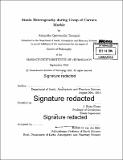Strain heterogeneity during creep of Carrara marble
Author(s)
Quintanilla Terminel, Alejandra
DownloadFull printable version (28.86Mb)
Other Contributors
Massachusetts Institute of Technology. Department of Earth, Atmospheric, and Planetary Sciences.
Advisor
J. Brian Evans.
Terms of use
Metadata
Show full item recordAbstract
Creep processes in calcite have been extensively studied, leading to the establishment of deformation mechanism maps. However, flow laws assuming a steady-state and homogeneous creep deformation cannot describe the strain localization and evolving structure described in numerous experimental and field studies. The micromechanical models need therefore to be revisited, and more experimental work and alternative methods to describe strain evolution are necessary. This work focused on the development of experimental and computational tools to describe strain at a micrometric scale, and their application to creep of Carrara marble. Two experimental series, one varying temperature (T), the other varying strain were performed in compression in a conventional triaxial apparatus (Paterson Instruments) at 300 MPa, T=400-700°C strain rate of 3 x 10 5 s- 1 and strains of 0.11, 0.22 and 0.36. Chapters 2 and 3 describe the microfabrication and computation technique developed for mapping deformation at a microscale. Chapter 4 describes the development of strain heterogeneity in the experimental series and Chapter 5 provides a complementary crystallographic analysis and preliminary work regarding modeling of the strain field. The experiments document a progressive transition as temperature increases from 400°C to 700°C , from a regime where twinning is an important mechanism of strain accommodation towards an increasing activity of intracrystalline slip systems. This transition is accompanied by a change in length scale of strain heterogeneity. At low T, strain is localized in bands spanning several grains. At high T, strain is more localized along grain boundaries. Furthermore, the wavelength of heterogeneities decreases to a quarter of the grain size, in parallel with an increase in their amplitude. This evolution is also seen at a grain scale and is accompanied by a greater change in crystallographic preferred orientation with respect to the undeformed natural sample, both at the low T and high T end-members of the series. The wavelengths of heterogeneities decrease with strain, suggesting the microstructure has not reached steady state despite a trend towards a local homogenization. This work provides a quantitative analysis of the evolution of intra- and intergranular strain partition, and gives a first insight into the adequate formulation of the evolving parameters in a constitutive law of creep deformation.
Description
Thesis: Ph. D. in Geophysics, Massachusetts Institute of Technology, Department of Earth, Atmospheric, and Planetary Sciences, 2014. Cataloged from PDF version of thesis. Includes bibliographical references (pages 217-226).
Date issued
2014Department
Massachusetts Institute of Technology. Department of Earth, Atmospheric, and Planetary SciencesPublisher
Massachusetts Institute of Technology
Keywords
Earth, Atmospheric, and Planetary Sciences.